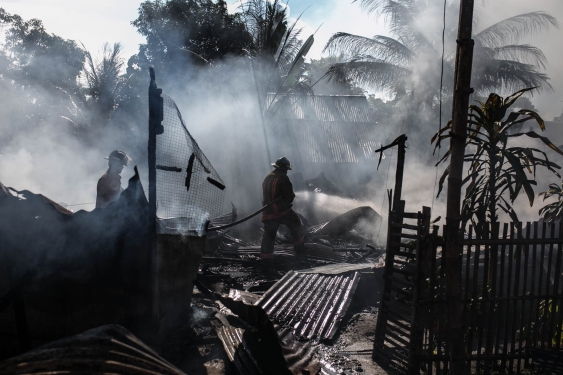How work should help when disaster strikes
From fires, floods and financial ruin, disaster can strike individuals anytime. But how should their workplace respond when it does?
From fires, floods and financial ruin, disaster can strike individuals anytime. But how should their workplace respond when it does?

If you have faced a natural disaster, you’ll know that the last thing on your mind is heading (or logging) into work.
With an increasing frequency and severity of natural disasters and other environmental disruptions, workplaces need to be looking to implement plans to support employees when disaster strikes, says Karin Sanders, Professor in the School of Management and Governance at UNSW Business School.
Workplace preparation for emergency management, even for unforeseen events like the 2020 bushfires, will be vital to supporting workers through disaster recovery and preventing undue stress and burnout.
Not only does disaster preparation help the business bottom line, but as we see more disasters, doing so will be considered a social responsibility.
Prof. Sanders examines how workplaces should respond to environmental disruptions, such as natural disasters, in her paper: Strategic human resource management in the era of environmental disruptions.

UNSW Business School Professor Karin Sanders says flexible work arrangements must be a critical support method as more workers face the effects of environmental disasters. Image: Supplied
In the study, 'environmental disruptions' are considered unexpected events with extreme impacts on society and businesses. The authors categorise the three worst environmental disruptions as:
In the paper, the COVID-19 pandemic is considered a natural disaster with massive unforeseen effects on existing working arrangements.
While economic uncertainty and the COVID-19 pandemic continue to impact Australians, Prof. Sanders says climate-related disruptions have the most significant potential to cause long-term harm and pose the biggest threat to workplaces and workers.
Data over the last century shows a sharp rise in environmental disasters; a tenfold increase in ecological disasters since the 1960s. Rising sea levels, droughts and other climate change-related events displace some 20 million people annually, with data pointing to human activity as a significant cause.
Experts warn environmental disasters will become more frequent and damaging, which means increases in climate-related disasters that impose high costs on businesses and society.
While businesses are increasingly taking steps to assess the risks and prepare for climate change, many still face internal and external challenges that hinder efforts to move toward greater sustainability and climate resilience. As well as emergency plans, workplaces should look at prevention plans to become more eco-friendly.
With environmental disasters expected to be more frequent, what should workplaces do to help manage the impact of natural disasters on workers?

With increasing global surface temperatures, extreme weather-related disasters like bushfires are predicted to become more frequent. Image: Pexels
Workplaces have a social responsibility to their communities – this is particularly important when environmental disasters strike and cause suffering, be it from extreme weather events, economic crises, or political insecurity, says Prof. Sanders.
For example, workplaces can quickly allocate relief efforts and human resources (like effectively managing frontline relief workers). This is a critical area where sustainable HR practices can provide valuable insights.
Businesses can help communities endure and overcome environmental disruptions by offering jobs that affirm workers' professional identity, giving a sense of normality and supplying financial resources.
Workplaces can also train workers to become more aware of the importance of sustainability in tackling climate change. Hiring employees who show an interest and awareness of social and ecological sustainability are just a few ways sustainable HR practices can be implemented.
For example, in recognition of its poor environmental impact, Royal Dutch Shell recently adopted a sustainable HR practice: linking directors' KPIs (and pay) with the group's climate performance and severing the link between bonuses and liquefied natural gas production volumes. While some companies are already doing this, others have been slow to adopt sustainability goals and need to catch up.
Prof. Sanders says workplaces should adopt sustainable HR practices to make employees more aware and motivated to work on the financial (profit), social (social responsibility), and ecological (environmental) goals of an organisation. She says these goals often align with the UN’s Sustainable Development Goals (SDG).

Workplaces can't predict when disasters might strike their workers, but they can adopt practices to ensure workers feel supported. Image: Pexels
Aside from the physical impacts of disasters, like the loss of a home, family member, or loved one during a natural disaster, these crises also threaten workers' wellbeing because they deplete emotional resources, explains Prof. Sanders.
This is a serious challenge for workplaces, as affected workers will show low job satisfaction, low job performance, high turnover intentions, and poor mental health, she says.
Fortunately, she says businesses have the means to mitigate this problem, as long as managers communicate effectively and compassionately during disaster events.
"Employees should be able to talk to their supervisor and work out individual flexibility arrangements," says Prof. Sanders. For example, supporting employees to work from home by ensuring they have all the necessary equipment (additional monitors, providing desks and good chairs etc.).
She says managers could also lower performance targets to help address stress sources. Managers can clarify that affected workers are welcome to find suitable arrangements; perhaps they don't have to come into the office or take on that extra project. At the same time, she says managers should recognise individual differences and not compare employees to each other.
Other key factors include transparency over who is given what benefits and flexibility. This can be achieved through a structure where standard employment agreements are shared across the organisation, says Prof. Sanders.
Ultimately, workplaces must realise that they play an essential role in helping employees maintain emotional wellbeing and productivity during disasters. And while they can't predict disasters, workplaces can ensure people feel supported.